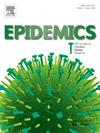Accounting for the geometry of the respiratory tract in viral infections
IF 2.4
3区 医学
Q2 INFECTIOUS DISEASES
引用次数: 0
Abstract
Increasingly, experimentalists and modellers alike have come to recognise the important role of spatial structure in infection dynamics. Almost invariably, spatial computational models of viral infections — as with in vitro experimental systems — represent the tissue as wide and flat, which is often assumed to be representative of the entire affected tissue within the host. However, this assumption fails to take into account the distinctive geometry of the respiratory tract in the context of viral infections. The respiratory tract is characterised by a tubular, branching structure, and moreover is spatially heterogeneous: deeper regions of the lung are composed of far narrower airways and are associated with more severe infection. Here, we extend a typical multicellular model of viral dynamics to account for two essential features of the geometry of the respiratory tract: the tubular structure of airways, and the branching process between airway generations. We show that, with this more realistic tissue geometry, the dynamics of infection are substantially changed compared to standard computational and experimental approaches, and that the resulting model is equipped to tackle important biological phenomena that do not arise in a flat host tissue, including viral lineage dynamics, and heterogeneity in immune responses to infection in different regions of the respiratory tree. Our findings suggest aspects of viral dynamics which current in vitro systems may be insufficient to describe, and points to several features of respiratory infections which can be experimentally assessed.
在病毒感染中考虑呼吸道的几何形状
越来越多的实验学家和建模者都开始认识到空间结构在感染动力学中的重要作用。几乎无一例外,病毒感染的空间计算模型——与体外实验系统一样——将组织表示为宽而平,这通常被认为是宿主体内整个受影响组织的代表。然而,这种假设没有考虑到在病毒感染的情况下呼吸道的独特几何形状。呼吸道的特点是管状分支结构,而且在空间上是不均匀的:肺的较深区域由窄得多的气道组成,并且与更严重的感染有关。在这里,我们扩展了典型的多细胞病毒动力学模型,以解释呼吸道几何结构的两个基本特征:气道的管状结构和气道世代之间的分支过程。我们表明,与标准的计算和实验方法相比,这种更真实的组织几何结构大大改变了感染的动力学,并且由此产生的模型能够解决在扁平宿主组织中不会出现的重要生物现象,包括病毒谱系动力学,以及呼吸树不同区域对感染的免疫反应的异质性。我们的研究结果表明,目前体外系统可能不足以描述的病毒动力学方面,并指出呼吸道感染的几个特征,可以通过实验评估。
本文章由计算机程序翻译,如有差异,请以英文原文为准。
求助全文
约1分钟内获得全文
求助全文
来源期刊

Epidemics
INFECTIOUS DISEASES-
CiteScore
6.00
自引率
7.90%
发文量
92
审稿时长
140 days
期刊介绍:
Epidemics publishes papers on infectious disease dynamics in the broadest sense. Its scope covers both within-host dynamics of infectious agents and dynamics at the population level, particularly the interaction between the two. Areas of emphasis include: spread, transmission, persistence, implications and population dynamics of infectious diseases; population and public health as well as policy aspects of control and prevention; dynamics at the individual level; interaction with the environment, ecology and evolution of infectious diseases, as well as population genetics of infectious agents.
 求助内容:
求助内容: 应助结果提醒方式:
应助结果提醒方式:


